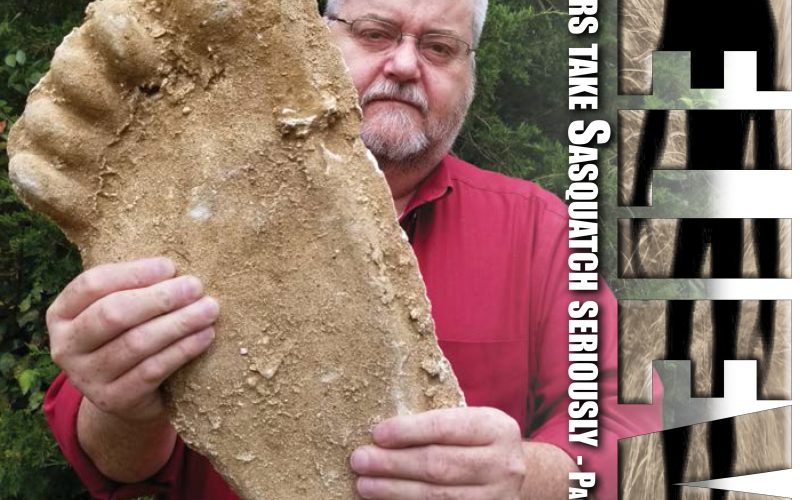Researchers take Sasquatch seriously
BECCA MARTIN-BROWN
bmartin@nwadg.com
D.W. Lee — who is a man of science — says he has seen Bigfoot on 26 different occasions.
Robert Swain — who is a man of God — says he’s heard rocks clapped together, tree knocks, whoops and the sound of the door handle of his car being lifted by what he believes was a Sasquatch.
Both of them were influenced as youngsters by the 1972 movie “The Legend of Boggy Creek,” set around Fouke, Ark. Lee, a computer geek, is now the head of the Mid-America Bigfoot Research Center in eastern Oklahoma, hosts of the Oklahoma Bigfoot Symposium this weekend in Stilwell, and Swain, a pastor, is the head of the Arkansas Primate Evidence Society, which holds its annual conference in the spring.
Both of them believe Bigfoot is a primate, not a missing link, not an alien, not “paranormal,” says Swain, unless it’s in the context of “outside of normal.”
“There are 19 million acres of forest in Arkansas,” says Swain, who is the minister at the Church of Christ in Vilonia. “And that’s not counting farmland nobody lives on. Bigfoot is nocturnal, it lives way back in the woods where we’re not, and it’s smart enough not to be seen.”
Lee adds that yes, he’s seen Bigfoot 26 times — out of about 4,000 forays into the woods to look for it. “That’s a very small percentage,” he says.

File Photo
A statue of Bigfoot stands on a table with other displays at a previous Arkansas Bigfoot Conference in Vilonia.
“The last time I saw it, a bunch of us had gone out to the valley where we do a lot of our research,” he says. “We had a white Bigfoot cross the trail in front of us, circle around, and cross the trail behind us. Two of us saw it — a male about 71/2 feet tall.
“What I tell people is if you go out in the woods and know what you’re looking for, you can’t really say they don’t exist,” Lee goes on. “Most people make enough noise in the woods, they don’t see any wildlife. Come on out [to the conference], and we’ll sit in the listening post overnight and be real quiet, and you’ll be surprised what you hear and see.”
Lee says members of his team have recovered a handprint and a footprint at the location where the symposium participants will hunt overnight. It’s in the same general area, says Swain, where he had his scariest encounter.
“It was about three years ago, dark, had been rainy all day, and I was parked at the end of a logging road — a good 20 miles to the nearest settlement,” he recounts. “I was sleeping behind the wheel of my car when something woke me, and the car was rocking from side to side. There was fog outside and condensation inside, so I couldn’t really see, but I distinctly heard the door handle being brought up and then dropped back into place.
“I really would like to have a sighting — but not in the car with me!”
Swain says he carries a handgun when he’s in the woods, “and for the first time in seven years, I reached for it, but when I moved inside the car, I heard it run off on two feet. The next morning, it was too rocky to see footprints, but something had pushed the side mirror on the car all the way in. I suppose it could have been a hobo … out on the river … in the middle of nowhere … in the middle of winter …”

Courtesy Photo
Casts of footprints are considered some of the best evidence Bigfoot exists, says D.W. Lee, the head of the Mid-America Bigfoot Research Center in eastern Oklahoma, hosts of the Oklahoma Bigfoot Symposium this weekend in Stilwell.
Lee says he’s also seen a young Bigfoot crossing a trail on all fours: “It looked like a baby gorilla,” he says, “going between two adults on either side of the trail. Bigfoot is really just a really smart, really big monkey.”
Lee’s conference will offer speakers, among them Lyle Blackburn, a crytozoology author; Randy Savig, director of the Missouri Mid-America Bigfoot Research Center; Mark Newbill, director of the Bigfoot Evidence Analysis: Sawdust Team; and Swain, along with footprint casts, tabletop displays, a chance to visit with researchers and camping to look for Bigfoot. If you’re going to camp with the researchers, though, Lee wants you to take it seriously.
“What you see on TV is all for entertainment purposes,” he says. “They’ve got camera crews, sound guys, a producer telling them how to react. When you actually get out there, you don’t light up the place with flashlights, and you try to stay quiet.”











